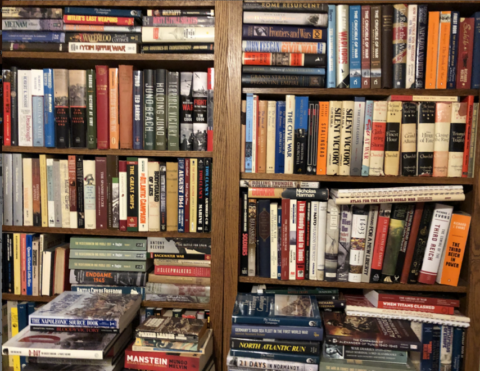World War Two
Published 19 Aug 2023This week the Allies invade Southern France, and do so very successfully. They’re also successful in the north, closing the Falaise gap and trapping huge numbers of Germans. In the East, however, the Germans manage to stop the Soviet drive on Riga with a counter attack, and in Warsaw they continue to brutally put down the Warsaw Uprising.
(more…)
August 20, 2023
Hitler Has a Bad Day – WW2 – Week 260 – August 19 – 1944
How to decode book blurbs
In The Critic, “The Secret Author” provides a glossary for industry outsiders to understand what the apparently glowing words of a blurb on a book cover actually mean:
Like many other professions, the book trade is keen on jargon: lots of it, the more the merrier. As with those other professions, it tends to be of two kinds: outward-facing, when publishers communicate with their customers; and inward-facing, when they communicate with other publishers or the people who write the products they sell.
Its function — the function of all professional jargon, it might be said — is simultaneously to create an easily intelligible code for the benefit of insiders and (frankly) to mystify and impress those beyond the loop.
Publishers’ outward-facing jargon can be conveniently observed in the blurbs printed on book jackets. These are full of code words which, you may be surprised to learn, usually have very little to do with the contents.
A good place to start in any consideration of jacket copy might be the late Anthony Blond’s still invaluable The Publishing Game (1971), in which the one-time kingpin of Anthony Blond Ltd and various successor firms identifies the real meaning of several of the key publishers’ cliches of the late 1960s.
They include Kafkaesque (“obscure”), Saga (“the editor suggested cuts but the author was adamant”), Frank or outspoken (“obscene”) and Well-known, meaning “unknown”. To these may be added Rebellious (“the author uses bad language”), Savage (“the author revels in sadism”), Ingenious (“usually means unbelievable”) and Sensitive (“homosexual”). Blond also offers a list of OK writers (Kafka, J.D. Salinger) with whom promising newcomers may profitably be compared.
Naturally, Blond’s list is of its time: nobody these days would think of labelling a gay coming-of-age novel “sensitive”. On the other hand, if the content has been superannuated, here in 2023 very little has changed in the form — which is to say that the modern book blurb is still awash with genteel euphemism and downright obfuscation.
Sometimes a blurb-adjective means its exact opposite. Thus powerful can invariably be construed as “weak”, whilst audacious or bold generally means “deeply conventional”. Shocking, obviously, means “not shocking” and challenging “not at all challenging”.
Then there are the contemporary buzzwords: transgressive, used to describe anything even a degree or two north of the sexual or ideological status quo; or immersive, which is another way of saying “reasonably engrossing”.
1908 Japanese Hino Komura Pistol
Forgotten Weapons
Published 26 Feb 2012The Hino-Komuro pistol (sometimes spelled Komura) was developed by a young Japanese inventor named Kumazo Hino, and financed by Tomijiro Komuro in the first decade of the 20th century. The gun uses a virtually unique blow-forward mechanism, which makes it very interesting to study. The rear of the receiver houses a fixed firing pin, and the barrel is pushed forward upon firing. To cock the gun, the barrel is manually pulled forward about one inch (using serrations on the exposed front section of the barrel). As the barrel is pulled forward, it pulls with it a follower that pulls a cartridge forward out of the magazine and lifts it up into the axis of the bore. When the grip safety and trigger are depressed, the barrel is snapped backwards into the action by a spring. The ready cartridge is chambered and driven backwards with the barrel onto the fixed firing pin.
(more…)
QotD: Fear of death
The two basic drivers of social change are fear of death and caloric surplus. They exist, as Marxists would say if they cared about actual human behavior, dialectically — the fear of death prompts a frantic search for caloric surplus; once attained, caloric surplus makes the once-adaptive fear of death neurotic and dysfunctional, literally morbid.
[…]
As pretty much every Victorian anthropologist remarked, “savages” all seem deliriously happy — when life is a constant struggle, your every moment is filled with deep meaning, high purpose. So, too, with men at war — Robert Graves or someone like that once said that his time in the trenches were the greatest moments of his life, because everything other than the now disappeared. I can’t speak from personal experience, but I’d lay good money that no combat veteran completely re-enters the civilian world, largely for this reason.
Those are reasonable fears of death. We all accept, intellectually, that we could go at any time, and we will inevitably go eventually, but unless you’ve had a brush with death — a moment where you know, with perfect clarity, that there’s a significant chance you’re going now — you can’t really appreciate it, emotionally.
Severian, “Communal Salvation”, Rotten Chestnuts, 2020-11-19.




